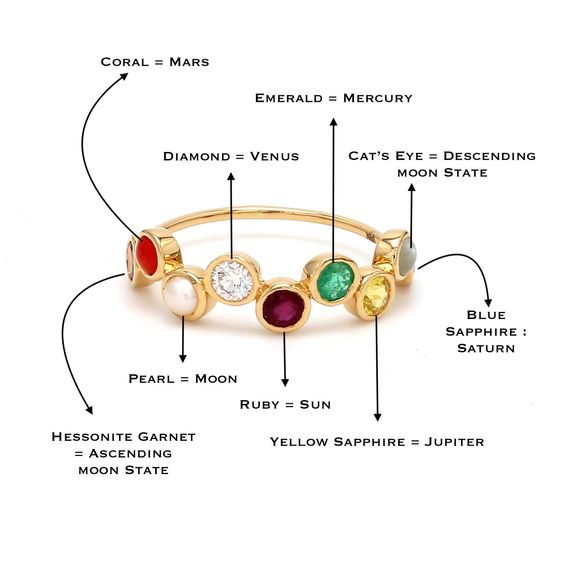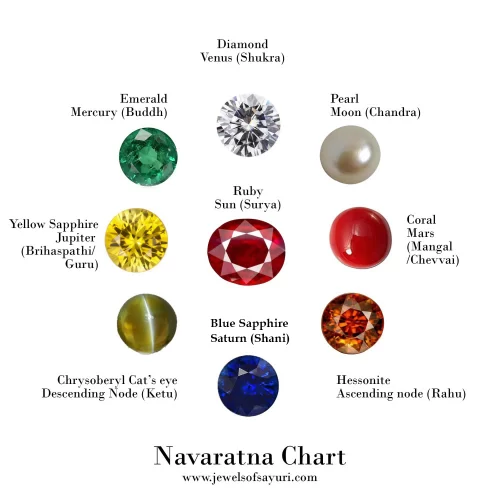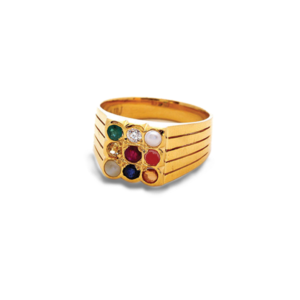The Ultimate Guide On Navaratna Ring
Significance of Navaratna ring
The significance of the Navaratna ring lies in the belief that each gemstone in the ring represents a specific planet and has unique astrological properties that can influence the wearer’s life.
The gemstones are believed to interact with the body’s energy centers or chakras, helping to balance and harmonize them, leading to improved health and well-being.
The Navaratna ring benefits are as follows:
- Astrological benefits
- Health Benefits
- Spiritual Benefits
- Emotional Benefits
- Protection Benefits
A Blend of Beauty and Astrology
Navaratna jewellery is a type of traditional Indian jewellery that incorporates the nine gemstones believed to have astrological and healing properties in Indian astrology.
The term “Navaratna” means “nine gems” in Sanskrit, and the jewellery is designed to bring balance and harmony to the wearer’s life by harnessing the energy of the nine gemstones.
Navaratna jewellery can come in many forms, including necklaces, earrings, bracelets, and rings.

The 9 stones in Navaratna
The nine stones or gems included in a Navaratna, which means “nine gems” in Sanskrit, are as follows:
- Ruby: It represents the planet Sun and is associated with confidence, creativity, and leadership.
- Pearl: It represents the Moon and is associated with calmness, emotional balance, and peace.
- Red Coral: It represents Mars and is associated with courage, strength, and protection.
- Emerald: It represents Mercury and is associated with intelligence, communication, and wisdom.
- Yellow Sapphire: It represents Jupiter and is associated with wealth, prosperity, and good fortune.
- Diamond: It represents Venus and is associated with love, beauty, and luxury.
- Blue Sapphire: It represents Saturn and is associated with discipline, hard work, and responsibility.
- Hessonite: It represents Rahu and is associated with spiritual growth, enlightenment, and protection against negative energy.
- Cat’s Eye: It represents Ketu and is associated with intuition, mystical experiences, and liberation from material desires.

Benefits of wearing Navaratna ring
The Navaratna ring is believed to have several benefits, which are related to the nine gemstones that it contains. Here are some of the benefits of wearing a Navaratna ring:
- Astrological Benefits: The Navaratna ring is said to provide astrological benefits by harnessing the energies of the nine planets in Indian astrology. It is believed that wearing the ring can help mitigate the negative effects of certain planetary alignments and promote positive energy in the wearer’s life.
- Health Benefits: Each of the nine gemstones in the Navaratna ring is associated with specific health benefits. For example, Pearl is believed to help with digestion, while Ruby is said to help with blood circulation. Wearing the ring is believed to balance the energies of the body’s chakras, promoting overall health and well-being.
- Spiritual Benefits: The Navaratna ring is considered a powerful talisman for spiritual growth and enlightenment. The gemstones in the ring are believed to enhance the wearer’s intuition, wisdom, and ability to connect with the divine.
- Emotional Benefits: The Navaratna ring is said to promote emotional balance and well-being. Each gemstone is associated with specific emotional qualities, such as courage, peace, and creativity, which can help the wearer to overcome emotional challenges and find inner peace.
- Protection Benefits: The Navaratna ring is believed to provide protection against negative energy and evil influences. The gemstones in the ring are believed to form a powerful shield around the wearer, guarding them against negative energies and helping them to stay safe and protected.
Overall, wearing a Navaratna ring is believed to bring positive energy, good luck, and well-being to the wearer. However, it’s important to note that the benefits of wearing a Navaratna ring are largely based on beliefs and not scientifically proven.
Origin of Navaratna jewellery
Navaratna jewellery has its origins in ancient Indian astrology and gemology. In India, the use of gemstones for astrological purposes can be traced back to the Vedic period, which dates back to around 1500 BCE.
In ancient India, the Navaratna was a popular gemstone combination used in various forms of jewellery, including rings, necklaces, and bracelets. The combination of nine gemstones was believed to represent the energies of the nine planets in Indian astrology and was said to provide powerful astrological and healing benefits to the wearer.
Over time, Navaratna jewellery became a popular form of adornment among Indian royalty and aristocracy. It was often worn by kings and queens as a symbol of their status and power, and was also believed to protect them against negative energies and evil influences.
Navaratna jewellery was also popularized by the Mughal emperors who ruled India from the 16th to the 19th century. The Mughals were known for their love of exquisite jewellery, and they brought with them the tradition of wearing Navratna jewellery to India.
Why people wear a Navaratna ring?
Fashion Statement: Apart from the astrological and spiritual benefits, that we have already discussed, the Navaratna ring is also a popular fashion accessory, especially in India. The ring can be worn as a statement piece, and it can complement a variety of outfits, from traditional Indian attire to western wear.
The most costly stone in Navaratna
The cost of each stone in the Navaratna can vary depending on its quality, size, and other factors. However, traditionally, the most valuable and expensive stone in the Navaratna is the diamond.
Diamonds are one of the most sought-after gemstones in the world, and their high value is due to their rarity, durability, and beauty. Diamonds are also associated with qualities such as clarity, purity, and abundance, making them a popular choice in Navaratna jewellery.
However, it’s worth noting that the cost of the Navaratna ring can also depend on the other gemstones used, as well as the metal used to make the ring. For example, Navaratna rings made with gold and high-quality gemstones can be significantly more expensive than those made with silver and lower-grade stones.
Metal Combination
According to astrology, the metal for a Navaratna ring can have an impact on the gemstones’ effectiveness in providing astrological benefits to the wearer. Each planet associated with a particular gemstone is also associated with a specific metal. Here is a general guideline:
- Sun (Ruby): The metal associated with the Sun is gold. Therefore, a gold Navaratna ring with a Ruby is considered auspicious for those seeking the Sun’s astrological benefits.
- Moon (Pearl): The metal associated with the Moon is silver. Therefore, a silver Navaratna ring with a Pearl is considered auspicious for those seeking the Moon’s astrological benefits.
- Mars (Coral): The metal associated with Mars is copper. Therefore, a copper or gold Navaratna ring with a Coral is considered auspicious for those seeking Mars’ astrological benefits.
- Mercury (Emerald): The metal associated with Mercury is gold. Therefore, a gold Navaratna ring with an Emerald is considered auspicious for those seeking Mercury’s astrological benefits.
- Jupiter (Yellow Sapphire): The metal associated with Jupiter is gold. Therefore, a gold Navaratna ring with a Yellow Sapphire is considered auspicious for those seeking Jupiter’s astrological benefits.
- Venus (Diamond): The metal associated with Venus is silver or platinum. Therefore, a silver or platinum Navaratna ring with a Diamond is considered auspicious for those seeking Venus’ astrological benefits.
- Saturn (Blue Sapphire): The metal associated with Saturn is iron. Therefore, an iron or gold Navaratna ring with a Blue Sapphire is considered auspicious for those seeking Saturn’s astrological benefits.
- Rahu (Hessonite Garnet): The metal associated with Rahu is lead. Therefore, a lead or silver Navaratna ring with a Hessonite Garnet is considered auspicious for those seeking Rahu’s astrological benefits.
- Ketu (Cat’s Eye Chrysoberyl): The metal associated with Ketu is silver. Therefore, a silver Navaratna ring with a Cat’s Eye Chrysoberyl is considered auspicious for those seeking Ketu’s astrological benefits.
It’s important to note that the metal used to make the Navaratna ring can vary depending on personal preference and budget. Ultimately, the decision should be based on a combination of astrological guidelines and individual preferences.
Our Metal Pick
Gold: Gold is a popular metal for Navaratna rings due to its durability, rarity, and cultural significance in India. Gold is also hypoallergenic and does not tarnish, making it a good choice for everyday wear. However, gold can be expensive, and the price can vary depending on the purity of the gold used.
Days to wear
The Navaratna ring can be worn during an auspicious time of the day, which varies depending on the planetary alignment. Astrologers recommend wearing the ring during the hour of the ruling planet associated with the gemstone in the ring. It is also considered important to wear the Navaratna ring on a specific day of the week based on the planet associated with the gemstone. For example:
- Ruby (Sun) – Sunday
- Pearl (Moon) – Monday
- Red Coral (Mars) – Tuesday
- Emerald (Mercury) – Wednesday
- Yellow Sapphire (Jupiter) – Thursday
- Diamond (Venus) – Friday
- Blue Sapphire (Saturn) – Saturday
- Hessonite (Rahu) – Saturday
- Cat’s Eye (Ketu) – Tuesday
It’s important to note that the effectiveness of the Navaratna ring in providing astrological benefits depends on several factors, including the quality of the gemstones used, the wearer’s birth chart and astrological factors, and other considerations. Therefore, it’s always best to consult with a trusted astrologer or jeweler before wearing a Navaratna ring for astrological purposes.
Suitable Suiters
According to Hindu astrology, anyone can wear a Navaratna ring regardless of their zodiac sign or birth chart. However, wearing a Navaratna ring is typically recommended for those who are going through a difficult phase in their lives or facing significant challenges in their personal or professional life.
Unsuitable Suiters
While anyone can wear a Navaratna ring, there are some cases where it is not recommended or advisable:
- People who have a history of allergic reactions to certain metals or gemstones should avoid wearing a Navaratna ring.
- Pregnant women and young children should avoid wearing Navaratna rings as it can affect the energy balance in their bodies.
- People who are facing serious health issues or undergoing medical treatment should consult their doctor or healthcare provider before wearing a Navaratna ring.
- People who are not inclined towards astrology or spiritual beliefs should avoid wearing a Navaratna ring as it may not hold any significance for them.
- If the gemstones in the Navaratna ring are not of good quality or if the ring is not made according to Vedic astrology guidelines, it may not provide any astrological benefits.
Wearing Guidlines
For men who wish to adorn a Navaratna ring, a customary practice is to wear it on the right hand fingers. This tradition is based on the belief that the right hand is associated with the active side and the giving of energy.
Actually, there is no specific way to wear a Navaratna ring, as it can be worn on any finger of either hand.
However, according to Vedic astrology, each finger is associated with a specific planet, and wearing the Navaratna ring on a particular finger can enhance the benefits of the corresponding gemstone. Here are some guidelines for wearing a Navaratna ring for males:
- Index finger (Jupiter finger): Wearing the Navaratna ring on the index finger is believed to enhance intellect, knowledge, and wisdom.
- Middle finger (Saturn finger): Wearing the Navaratna ring on the middle finger is believed to bring stability, success, and career growth.
- Ring finger (Sun finger): Wearing the Navaratna ring on the ring finger is believed to improve creativity, leadership skills, and self-expression.
- Little finger (Mercury finger): Wearing the Navaratna ring on the little finger is believed to improve communication skills, business acumen, and financial success.

Female Wearing Guidline
For women who wish to wear a Navaratna ring, a common practice is to wear it on the left hand fingers. This is based on traditional beliefs that associate the left hand with the receiving of energy and the feminine side.
Related Questions
Is it safe to wear Navaratna ring?
Wearing a Navaratna ring is generally considered safe, and many people wear it for both its aesthetic value and astrological benefits.
Is it Navaratna or Navratna?
Both spellings, Navaratna and Navratna, are correct, and they refer to the same thing – the nine-gemstone combination used in traditional Indian astrology and jewellery. The spelling “Navaratna” is more commonly used in Sanskrit and Hindi, while “Navratna” is a more commonly used transliteration in English. So, it depends on the language and context in which it is used.
